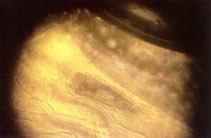
picture (AcanthD0.jpg) by Bassleer, G. |

picture (AcanthD1.jpg) by Bassleer, G. |
cfm script by eagbayani, 10.05.99 ,
php script by kbanasihan 05/27/2010 ,
last modified by sortiz, 06.27.17
| Main Ref: | 26129 |
| Disease type: | Parasitic infestations (protozoa, worms, etc.) |
| Disease name: | Acanthocephalus Infestation |
| Other names: | Tornyheaded worm infestation; Hookworm infestation |
| Caus. agent: | Acanthocephalus sp. |
| Group: |
| Part of body and/or behavior affected by disease: | ||
| Skins and/or fins | Belly | Swimming behavior |
| Gills | Anus | Other behavior |
| Eyes | Viscera Afflicted | Other symptoms |
| Fish affected: | ||
| Symptoms: | On the first stages of the diseases the fish wil emaciate but will show a good appetite. After this they will weaken because of their injuries and secondary bacterial infection will appear.The fish may also exhibit fin- and tailrot, skin patches or sores (which is secondary bacterial infection), excrements are usually white and stringy or slimy. Ref. 41805 | |
| Treatments: | Infected large fish (e.g. Discus) can be treated with Trichlorfon (Dose: 0.25-3.0 mg/1 liter water for 3 days), however caution should be taken for smaller species (e.g. Angelfish and Cardinal tetras). Also the use of Niclosamide (Dose: 0.5gm to a bit of food (100gm) and mix it thoroughly. This can be done with gelatine or vegetable oil), Levamisole (Dose: 100mg of the medicine in 25gm of fish food) or Mebendazole (Dose: 100-200 mg/100L for 2-3 days, afterwards water change should be made) mixed with the fish food can have good results (Ref. 41805). | |
| Prophylaxis: | Avoid the use of live food. Ref. 41805. | |
| Remarks: | Often found in the intestine of wild caught species. Ref. 41805 spelled the genus as Acanthocephales. Ref. 41805 | |
| Mortality and seasonality | ||
| Mortality: | ||
| Seasonality: | ||
| Back to Search |

picture (AcanthD0.jpg) by Bassleer, G. |

picture (AcanthD1.jpg) by Bassleer, G. |